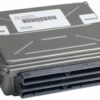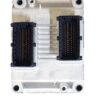Is Your GM Truck or Van Running Rough? The PCM Might Be the Culprit.
If your 2005-2007 Chevrolet Silverado, GMC Sierra, or other compatible GM vehicle is experiencing frustrating issues like a persistent check engine light, poor fuel economy, erratic shifting, or even a no-start condition, the problem may lie with its electronic brain: the Powertrain Control Module (PCM). The PCM, also known as the Engine Control Module (ECM), is the central computer responsible for managing everything from fuel injection and ignition timing to transmission shift points and emissions systems. When it begins to fail, it can cause a cascade of problems that are often difficult to diagnose.
From the Diagnostic Bay
We once had a 2006 Silverado 2500 with the 8.1L engine towed in. The owner had spent a fortune replacing sensors, spark plugs, and even the fuel pump, chasing an intermittent stalling issue that no one could figure out. The truck would run fine for days, then suddenly die at a stoplight. Our initial scan showed no hard codes, just a history of lost communication with various modules. After running a full diagnostic on the CAN bus network, we isolated the issue to the PCM itself. An internal fault was causing it to periodically drop offline, killing the engine. We installed a VIN-programmed PCM, performed the security relearn, and the truck ran perfectly. It’s a classic example of how a failing module can mimic a dozen other mechanical problems.
Common Symptoms of a Failing PCM
- ✔ Check Engine Light: An illuminated or flashing check engine light is one of the most common signs, often with codes related to module communication, sensor circuits, or processor faults.
- ✔ Engine Performance Issues: You may experience rough idling, engine misfires, hesitation during acceleration, or a noticeable loss of power.
- ✔ Poor Fuel Economy: A faulty PCM can’t properly regulate the air-fuel mixture, leading to a sudden and significant drop in your vehicle’s gas mileage.
- ✔ Transmission Problems: The PCM also controls modern automatic transmissions. A failing unit can cause harsh shifting, delayed engagement, or getting stuck in one gear (limp mode).
- ✔ No-Start Condition: In severe cases, the PCM can fail completely, preventing the engine from starting at all. The engine may crank but will not fire up because the PCM isn’t commanding the fuel injectors or ignition coils.
- ✔ Failed Emissions Test: The PCM is critical for managing your vehicle’s emissions systems. A malfunctioning module will almost certainly cause you to fail an emissions inspection.
The Simple Solution: A VIN-Programmed 2005-2007 Silverado PCM
Replacing a PCM isn’t just about swapping a box. A new module from the dealership is a blank slate; it requires expensive and complex programming using specialized tools to make it work with your specific vehicle. Our solution eliminates that hassle. This Powertrain Control Module, part number 89017749 (also compatible with 12589462 and 12602801), is the perfect fix for a wide range of GM vehicles. We take the complexity out of the repair by programming the module specifically for your truck or van before it ever leaves our facility.
Here’s how it works:
- Place your order for the PCM.
- Provide us with your vehicle’s 17-digit Vehicle Identification Number (VIN) during or after checkout.
- Our technicians will use your VIN to access the latest, most stable software updates directly from GM.
- We flash the module with this specific software, ensuring it is a perfect match for your vehicle’s engine, transmission, and options.
- We ship the ready-to-install module directly to you.
This process ensures that when you receive your part, it’s ready for a straightforward installation. In most cases, after installation, you will only need to perform a simple security relearn procedure (often called a key relearn or anti-theft relearn), which can typically be done in your driveway without any special tools. This restores communication between the PCM and your vehicle’s anti-theft system. For some vehicles, a Crankshaft Variation Relearn (CASE Relearn) may be needed to clear a P1336 code, which requires a capable scan tool.
Don’t let a faulty computer keep your reliable GM truck off the road. This isn’t just a replacement part; it’s a complete, programmed solution designed to restore your vehicle’s performance, reliability, and drivability. Get the brain of your vehicle operating at peak efficiency again.
Frequently Asked Questions
Do I need to get this PCM programmed by a dealer?
No. We handle all the programming for you before we ship the part. Simply provide us with your vehicle’s VIN, and we will flash the module with the correct GM software for your specific configuration.
What is a VIN and why do you need it?
The VIN is your vehicle’s unique 17-digit identification number, like a fingerprint. It tells us the exact year, make, model, engine, transmission, and other options your vehicle was built with. We use this to load the precise software required for your truck to run correctly.
Where is the PCM located on my 2006 Silverado?
On most 2005-2007 Silverado and Sierra pickups, the PCM is located in the engine bay on the driver’s side, under the battery tray. For GM vans like the Express and Savana, it is typically found in the LH rear of the engine compartment.
Is this part difficult to install?
The physical installation is generally straightforward for someone with basic mechanical skills. It involves disconnecting the battery, removing the old module, and plugging in the new one. However, you will need to perform a security relearn procedure afterward, which can usually be done without special tools. Instructions are widely available online.
Will this fix my specific problem or check engine light code?
This PCM will resolve issues directly caused by a faulty module. If you have codes related to internal processor failure, communication errors (U-codes), or multiple unrelated circuit faults, a bad PCM is a very likely cause. However, proper diagnosis is key. Ensure your issue isn’t caused by bad wiring, grounds, or a failed sensor before replacing the module.


